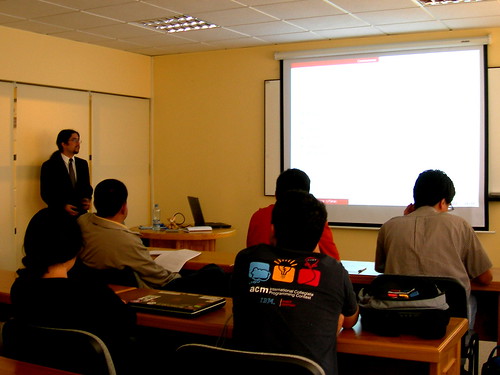Go forward in time to April 2008.
- Thu 2008/Mar/27
- Tue 2008/Mar/25
-
-
I love beamer, but there is this small issue that makes it impossible to use properly in a non english nor german presentation: The example, theorem, definition, and similar environments are hardcoded to english. If you need to do a talk in German, beamer author was kind enough to provide with Beispiel, Lemma, Definition, and others. But if you need to do a talk in any other language, then you are on your own.
If anyone knows how to cope with this and be able to redefine the titles for these environments, I'd really appreciate it.
Update: an inspection of beamer templates has lead me to realize that beamer uses a strange way of translating. You need a package called translator that is in beamer CVS, but it's not totally documented, nor packaged in a useful form.
Update 2: To get your beamer talk properly translated to Spanish, do the following:
- Download the files translator.sty and translator-language-mappings.tex. Install them in the proper way for your distribution (instructions for Debian here). You can optionally download the documentation and place it in the proper place, of course.
- Get my dictionary of mathematical terms from here. If you need to translate other stuff, get the original ones from beamer's CVS.
- Put the dictionary files together with the files downloaded in (1).
- Use spanish as a parameter for the document class definition. Beamer will take care of passing that parameter to the translator package.
- Compile. Enjoy.
Now you should be able to defend your dissertation with a properly localized talk. Good luck with that!
-
- Sun 2008/Mar/23
-
-
Following up my entry on GBookmarkFile and the desktop, I wrote today a small program to clean up a given bookmarks file. Given a XBEL file, it'll remove all the entries for nonexistent files.
I used it to clean up my own ~/.recently-used.xbel, which shrank from 5.3MB to 1.8MB. Notice that this will remove all entries for files that cannot access, including the entries for items in removable media that is not plugged in. I think that this could be improved by using g_file_query_info, but it's Sunday and I want to go out and take a walk. :-)
Get it from here. Patches and comments are, of course, welcome. Use it under your own risk!
-
- Sat 2008/Mar/22
-
-
One thing, that EOG users have been complaining lately about, is the large time spent during image switching. Thanks to sysprof, I had discovered a while ago that a considerable part of that time is spent in saving the GBookmarkFile used by GtkRecentManager to ~/.recently-used.xbel.
The first thing I did, to alleviate users, was to delay the saving operation of the GBookmarkFile to a low priority idle call. This way, when a user switches between images, she first notices the image change before the bookmarks file is updated, which gives a good responsiveness impression.
Problem is, that when a user wants to switch between images really quickly, she is going to notice the slowdown anyway. So, either a complete change in the way we handle recently used files is needed, or real optimizations should be done.
Felix and I found some things that could be optimized during the creation of a GBookmarkFile file. We filed bugs about it (#518160, #523877), and Emmanuele has been very helpful on this, so there'll be some improvements in the saving time. Good.
However, I still have the feeling that letting ~\.recently-used.xbel grow without control is very, very wrong. In my laptop, this file is about 5MB, which accounts for ca. 9000 files(!). Also, loading it completely every time an application gets the default GtkRecentManager and saving it each time a user selects a different file, is also very suboptimal. We really need to do something about this.
-
- Thu 2008/Mar/13
-
-
Dissertation delivered. Now to prepare for the defense.
-
- Wed 2008/Mar/12
-
-
It's both fun and a bit of pathetic that now that our timezone for the rest of the month is not CLST (Chilean daylight saving time) but CLBT (Chilean Bachelet time), I receive lots of mails from the future.
If you live in Chile, do me a favor: set your timezone to BRT (brazilian time) for the rest of the month. Thanks.
-
Hughsie: maybe you are failing to pass the Turing test? :-)
-
And the community made it in time again...
Enjoy it!
-
- Tue 2008/Mar/11
-
-
Yesterday, we released the Eye of GNOME 2.22.0. This is a major release to be included in GNOME 2.22, to be released tomorrow.
This is mostly a polishing release after the big rewrite we did for 2.20. There are tons of bugs fixed, many memory and performance improvements, and also a small bunch of features came in.
I want to thank to everyone who contributed during the last 6 months with patches, testing, suggestions, translations, documentation, and the like. Special kudos, as usual, to my good friends Felix and Lucas.
-
Yesterday, a new t-shirt arrived from France. Thanks to Vincent (nowadays most known as Mr Ice-cream) for sending me one of those nice FOSDEM GNOME t-shirts (it arrived the right day!)
-
My dissertation is almost ready to be handed out. I need to polish a bit the results chapter, and will be delivering really, really soon.
-
Thanks to everyone who one way or another greeted me yesterday!
-
Now that I'm working on getting a highly polished document for my thesis, I thought I better share some of the non-trivial stuff I've been using to make it look pretty.
-
For documents in Spanish, hyphenation can be problematic. Some words may not be correctly hyphenated, so you need to add them to the preamble under \hyphenation. Every LaTeX user knows that.
The problem is that if you need to add to that list any word in Spanish that has an acute or any accentuation mark, it may cause problems during compilation. To avoid that, use the fontenc package and specify the T1 encoding.
-
You may want to use pdftex to get a PDF summary. If the title of your document, or your name has also accentuation marks, you need to set unicode=true in the options for the package, and add your accentuation marks in the old TeX way: \'a, \'e, and so on. Otherwise, you'll be yet another one to fill the internet with documents with PleaseinsertPrerenderUnicode{x}intopreamble messages.
-
The default font size for tables, figures, and other bodies' captions is the same than the size for the document text. This may cause confusion for some of your readers, so it's better to use a smaller font for the captions. To get this, I added the following to the preamble:
% Different font in captions \newcommand{\captionfonts}{\small} \makeatletter % Allow the use of @ in command names \long\def\@makecaption#1#2{% \vskip\abovecaptionskip \sbox\@tempboxa{{\captionfonts #1: #2}}% \ifdim \wd\@tempboxa >\hsize {\captionfonts #1: #2\par} \else \hbox to\hsize{\hfil\box\@tempboxa\hfil}% \fi \vskip\belowcaptionskip} \makeatother % Cancel the effect of \makeatletter -
I needed to add enumerated examples, for clarity. This is not hard to do, but here's how I did it anyway. You can use for this the asmthm package, and create a new theorems class. The following in the preamble of your document
\newtheoremstyle{example} {\topsep} {\topsep}% {}% Body font {}% Indent amount (empty = no indent, \parindent = para indent) {\bfseries}% Thm head font {.}% Punctuation after thm head { }% Space after thm head (\newline = linebreak) {\thmname{#1}\thmnumber{ #2}\thmnote{ (#3)}}% Thm head spec \theoremstyle{example} \newtheorem{example}{Ejemplo}[chapter]will allow you to do something like
\begin{example}[gramática para un lenguaje] Considérese el lenguaje de todas las palabras compuestas únicamente por pares de paréntesis balanceados, descrito recursivamente como: ... \end{example}to get something like
Ejemplo 2.1 (gramática para un lenguaje). Considérese el lenguaje de todas las palabras compuestas únicamente por pares de paréntesis balanceados, descrito recursivamente como: ...
I collected the ideas for these tricks and some code snippets from the web. I don't recall exactly where from, so no links this time.
-
-
- Fri 2008/Mar/07
-
-
Dear Spanish translator of Debian's su(1) command:
Could you please bring me back the space after the colon on the Password prompt? In Spanish, a space after comma, colon, semicolon and so on, are mandatory. kthxbye.
Update: Filed in Debian's BTS.
-
Go backwards in time to February 2008.

